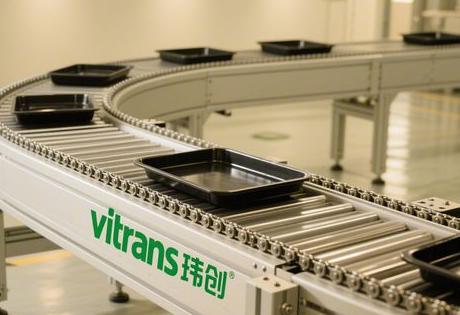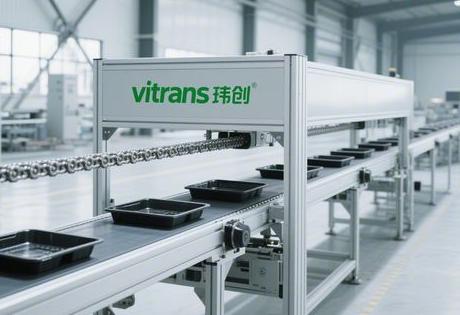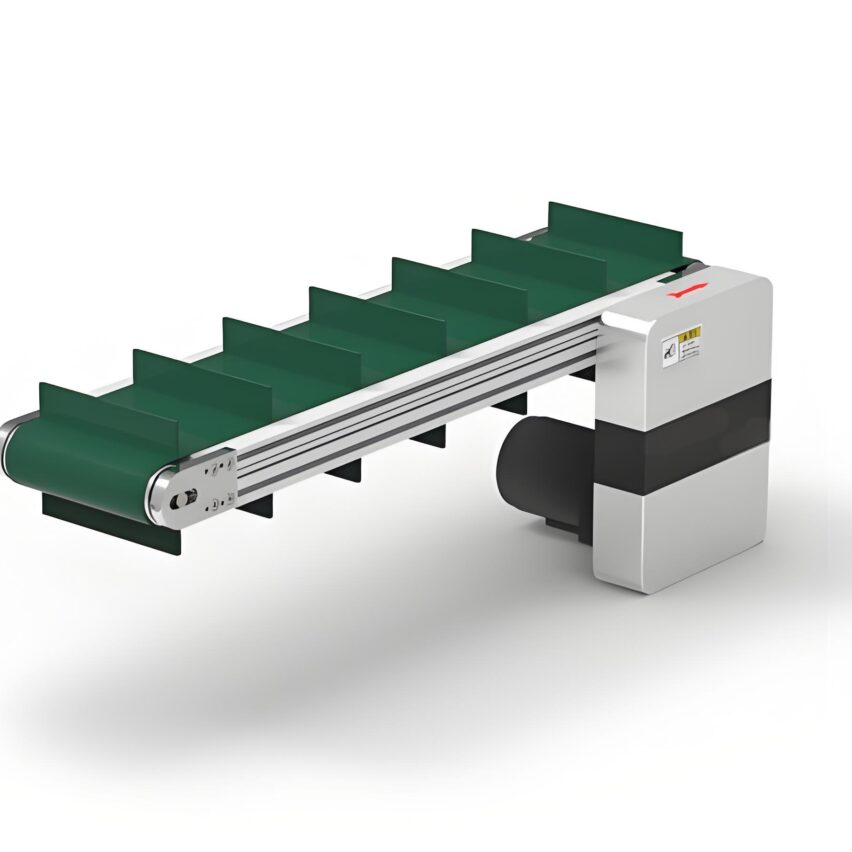I. Technical principles and structural innovations: engineering breakthroughs in heavy-duty conveying
The core of the multiplier chain conveyor system for box cars (e.g. SUVs, MPVs) is theSolving the contradiction between dynamic stability and accurate positioning of large volume bodywork. Conventional doubler chains rely on the difference in diameter between the roller (diameter R) and the roller (diameter r) to achieve the speed increase of the workpiece (formula: Vtooling board
= Vsprockets
× (R/r + 1)), but for the special needs of boxcars, a triple technology upgrade is required:

- Design for torsional loadsAdopt chrome-molybdenum alloy steel roller (single point load-bearing 500kg), with V-guide self-correcting structure, body offset ≤ 0.3mm/10m;
- Multi-stage buffer system: Air spring + hydraulic damping composite damping, amplitude control within ± 0.5mm, to avoid welding deformation;
- Heavy-duty dynamic speed regulationServo motor + magnetic levitation auxiliary drive, speed range 0.5-8m/s stepless switching, suitable for welding/assembly of different beats.
personal viewpointThe essence of the box-type automotive speed chain is "a precise controller of space and time". The actual test data of a car enterprise shows that after adopting the modular speed multiplier chainProduction line switchover time reduction 83%--The value lies not only in the conveying efficiency, but also in the "three-dimensional return closed loop" to eliminate the body lifting empty space, reconstructing the whole vehicle manufacturing process.
II. Upgrading core components: from mechanical drives to intelligent synergies
1. Chain and guide innovation
- Composite link structure: Inner 42CrMo alloy steel load-bearing (tensile strength 1500MPa), outer polyurethane noise-reducing layer (hardness 90 Shore A), 85% reduction in wear dust;
- High temperature resistant guide rail: Anodised aluminium base + ceramic coating, temperature resistant to 250°C, life time up to 3 times that of normal carbon steel.
2. Tooling plates and positioning systems
- Adaptive FixturePneumatic servo jaws + laser scanning positioning, compatible with different wheelbase models (2.6m-3.1m), switching time <3 minutes;
- Conductive Integration Technology: The workpiece plate has a built-in slide-contact power supply system (voltage 380V±5%), which supports simultaneous operation of welding robots.
3. Intelligent control centre
plaintextmake a copy of| Functional Modules | Technical Solutions | Performance Enhancement | |----------------|-------------------------|--------------------| | Synchronised Positioning | Encoder+PLC Closed Loop Control | Stopping Error ≤±0.5mm | | Fault prediction | Vibration sensor + AI analysis | Downtime reduction 60% | | Energy Management | Regenerative Braking + Frequency Control | Energy Consumption Reduction 38% |After the application of an MPV production line, the daily production capacity of a single line was increased from 120 units to 200 units.
Third, the industry application scenario: from welding to assembly of the whole process of empowerment
Body Welding Line
- Precise positioning of the body-in-white: Pneumatic-electric dual-control stopper (response time 0.1 seconds) ensures repeatable positioning accuracy of ±0.1mm for welding robots;
- Multi-level three-dimensional conveying: The jacking transplanter enables seamless integration of the welding-painting line, increasing space utilisation by 40%.
Paint shop
- Corrosion-resistant transmission: Fully sealed stainless steel chain cabin + negative pressure dust prevention system, isolating paint mist pollution (isolation efficiency 99.99%);
- High Temperature Baking Adaptation: Silicone coated chains run continuously at 180°C for 3000 hours without deformation.
Assembly line
- Flexible Mixed Flow ProductionRFID identification of model configuration, automatic switching of jigs and fixtures, and support for fuel car/electric car co-production;
- Ergonomics optimisation: Electric height adjustment of the wire body (700-1100mm), adapted to the different processes of chassis assembly and interior installation.
IV. Smart Maintenance and Sustainability: Reconstructing Full Life Cycle Value
1. Predictive maintenance system
- Wear Particle Monitoring: The lubricant has a built-in ferromagnetic sensor and an automatic alarm for wear exceeding the limit;
- digital twin operations and maintenance (DTOM): Virtual model predicts chain fatigue points and extends maintenance intervals by 30%.
2. Green manufacturing practices
- Lightweight frameworkReplacement of carbon steel by aerospace aluminium profiles (weight reduction of 35%), with a reduction of 42 tonnes/year in carbon emissions from the production line;
- Dry lubrication technology: Molybdenum disulphide solid coating with a coefficient of friction of 0.02, maintenance-free for life.
V. Future trends: convergence of digital twins and flexible manufacturing
I think the next generation of multiplier chains will move towards"Reconfigurable Physical Systems + Cloud Decision Brain"Evolution:
- Dynamic Topology Adjustment: Real-time optimisation of delivery paths based on 5G + edge computing, with production line restructuring time compressed to 1 hour;
- mass twin mapping (math.)Generate digital passports for each body, record vibration/temperature and humidity data during conveyance, defect traceability response <5 seconds;
- Carbon Footprint Visualisation: Real-time display of energy consumption indicators per metre of conveyor chain, driving the factory towards ISO 50001 certification.
Exclusive data: 2026 industry white paper shows boxcar factory with smart multiplier chain.Reduced consolidated cost of a single line by 31%--Its disruptive nature is not simply cost reduction, but the "conveyor-as-quality-inspection" model that stops 99.2% of assembly errors in the middle of the production line.
Self-questioning on core issues
Q1: How to cope with the mixed production of different wheelbase models?
Third-order adaptive programme::

- Dynamic adjustment of fixtures: Pneumatic servo actuator telescopic range ±300mm, compatible with 2.6m-3.1m wheelbase;
- RFID intelligent identification: The frame VIN code automatically triggers the switching of the tooling board parameters;
- Synchronous belt compensation mechanism: Ensure that the deviation of the body centreline from the conveyor axis is <0.8mm.
Q2: How to avoid the risk of chain breakage in heavy load conveying?
Dual safeguard mechanism::
- Tension monitoring in real time: Dynamic adjustment of tensioning force by strain transducer (fluctuation ≤±0.5N);
- Overload fuse design: Automatic stop when torque threshold reaches rated value 120% to protect chain structure.
Q3: How can old plants be adapted to new multiplier chains?
Phased Retrofit Strategy::
- Compact drive unitsThickness: ≤200mm, suitable for 4m height plant;
- Hybrid Protocol Gateway: Supports PROFINET/EtherCAT conversion and is compatible with the 85% existing PLC system;
- Local reinforcement techniques: Enhancement of commitment points only, with a 60% reduction in remodelling costs.
Industry InsightsThe ultimate mission of the box car speed chain is not to "move the body faster", but rather to make it easier to move the body through theConverting conveyor lines into "mobile assembly platforms".--When the body-in-white completes quality checks and data collection for every metre of movement, automotive manufacturing moves from an "assembly line operation" to a "value stream engine". The value stream engine".













